Crafting Powerful (Yet Simple) LinkedIn Creative

With over 1 billion members, and access to key decision-makers across industries, LinkedIn is the go-to platform for professionals to connect, engage, and make strategic decisions. That being true, standing out amidst the noise requires more than just targeting the right audience — it’s about crafting creative and compelling ad content that resonates.
It’s crucial to remember that creative is the single most important input contributing to advertising performance, followed by Media. Yes, your creative is more important than reach, recency, targeting, and context combined.
In this blog post, we’ll explore creative best practices for LinkedIn ads, from messaging to design, to ensure your brand captures attention, communicates value, and drives meaningful engagement with your B2B audience.
In this post, we’ll explore creative best practices for LinkedIn ads, from messaging to design, to ensure your brand captures attention, communicates value, and drives meaningful engagement with your B2B audience.
An Overall Framework for B2B LinkedIn Creative
81% of B2B buyers buy the brand that comes to mind on day one. This is a powerful statement that you must always keep in mind. B2B creative needs to be approached with a long-term mindset, as brand advertising plays a crucial role in shaping future business outcomes. Unlike performance marketing, which captures immediate leads, effective brand advertising focuses on creating demand among future buyers. The majority of potential customers aren’t in-market at any given time, but when they eventually are, they should already be familiar with your brand.
This approach to advertising builds mental availability, ensuring your brand is top of mind when key decision-makers are ready to purchase. By linking your brand to relevant buying situations, your ads increase the likelihood that your brand will be chosen. Over time, this strategy strengthens customer retention, improves pricing power, and helps reduce churn, making your brand a familiar and trusted option in competitive markets.
Much like a smart investment strategy, brand advertising delivers both short-term and long-term returns. Investing in creative that reinforces strong memory structures pays off as more buyers enter the market, ensuring your brand remains relevant and preferred when it matters most.
LinkedIn has stated that there are three elements that have to be measured and considered in order to be able to drive business outcomes:
1. Attention
To successfully transfer an idea from a screen to a buyer’s mind, B2B advertising must first capture attention. Without attention, no ad can be effective. Research shows a direct link between attention and short-term sales response, making dwell time (the amount of time someone spends engaging with an ad) a key indicator of success. In a crowded digital space, where content from multiple brands competes for the same audience, the ability to stand out becomes critical.
To gain attention, an ad must be viewable, relevant, and creatively distinctive. While good targeting ensures the ad reaches the right audience, the LinkedIn creative itself must catch the viewer’s eye, prompting them to pause and engage. Unfortunately, most B2B ads lack this creative standout, with only a small fraction scoring well in terms of attention and emotional engagement.
Ad format also plays a role in determining how much attention it receives, with videos often outperforming static formats due to their ability to evoke emotion and hold attention longer. Context matters too—ads placed alongside relevant content tend to perform better, especially when they align with the audience’s professional interests.
Investing in high-attention creatives can significantly impact a brand’s share of attention and, consequently, its market share growth. Brands should focus on identifying and scaling LinkedIn creative that consistently capture attention while retiring those that do not.
Here are some effective examples:
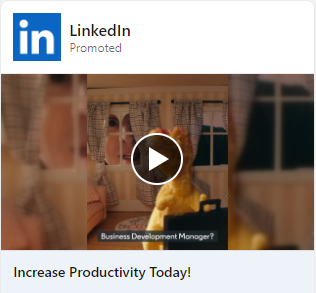
It’s funny and simple (video). Here’s another:
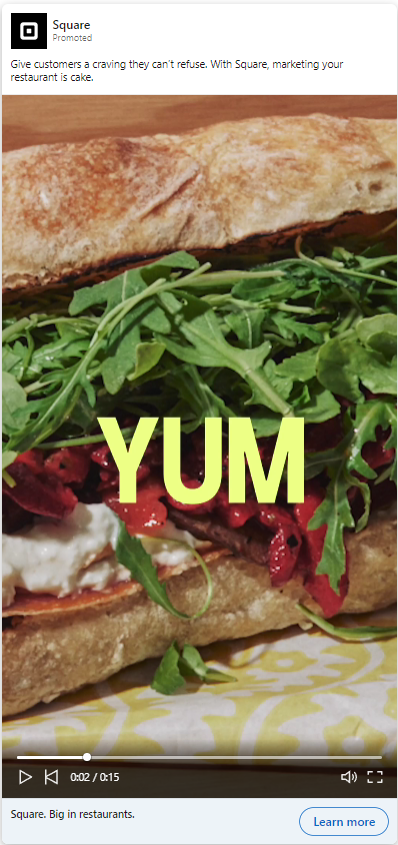
Zooming in on a delicious sandwich means we are all stopping at this ad during lunch or snack time!
2. Branding
In addition to securing viewers’ attention, it is crucial to ensure that ads are correctly attributed to the brand. If people cannot remember your brand or mistake it for that of a competitor, the advertising investment is wasted. Effective branding ensures that positive impressions are linked to your brand, making it more likely that your audience will remember and consider your business when making purchasing decisions.
Brand attribution is driven by the use of Distinctive Brand Assets (DBAs) — elements such as logos, colors, sounds, or characters that make your brand easily recognizable. DBAs should be integrated early and often in your ads to reinforce your brand identity. Research shows that the majority of B2B ads struggle with effective branding, leading to low recognition and minimal market share growth. By incorporating DBAs prominently and consistently across campaigns, businesses can improve their brand’s visibility and create lasting impressions in the minds of buyers.
Successful branding doesn’t just depend on logo placement or brand mentions. It involves creating a design code that differentiates your brand from competitors, ensuring that your ads are memorable and easily identifiable. In B2B, where creative distinctiveness is often lacking, investing in DBAs presents a significant opportunity to improve brand attribution and drive long-term recognition.
Take a look at some strong examples below:
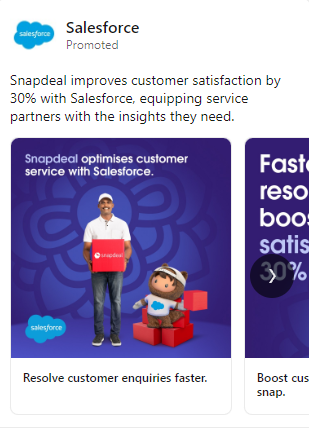
The moment you see Astro, you know you are talking about Salesforce.
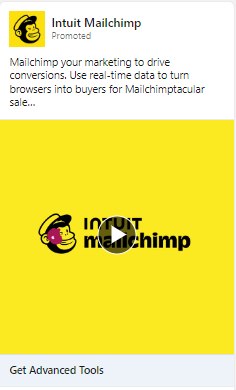
The monkey from Intuit Mailchimp is another great example.
3. Linkage
Linking your brand’s messaging to specific buying situations is a concept known as linkage. Memories are situational, meaning that people remember ads based on the context in which they see them. Therefore, to make your advertising effective, it must illustrate the key buying situations where you want your brand to come to mind.
Keyword density can help measure this linkage by analyzing the frequency of keywords in your ads and weighting them based on how long people engage with the content (dwell time). This approach allows advertisers to assess how well their messages align with relevant buying situations and whether they are making a lasting impression.
Linkage matters because the more often your brand is associated with specific buying situations, the more likely it is to be considered when a buyer enters the market. This can be achieved by focusing your messaging on Category Entry Points (CEPs) — common cues that trigger brand recall when a buyer begins searching for solutions in your category. Brands that effectively link themselves to key CEPs tend to achieve higher buyer penetration, making their products or services top of mind when purchase decisions are made.
To maximize the effectiveness of linkage:
- Identify the buying situations most relevant to your brand.
- Build your messaging around those situations.
- Consistently reinforce these linkages across your ads to create strong memory structures that will increase brand consideration over time.
By focusing on these situational cues, your brand can build the mental penetration needed to drive long-term success in the B2B space.
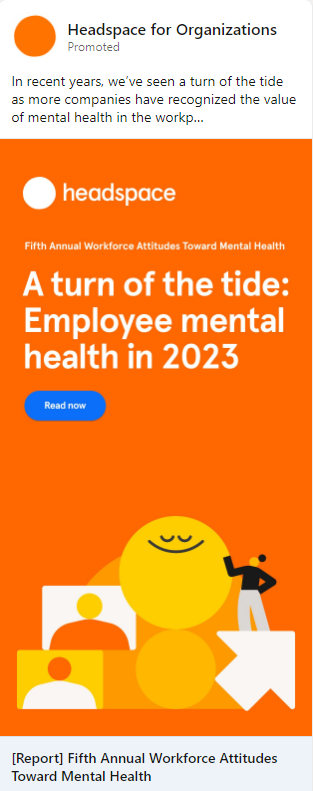
It is very clear that this is a B2B ad, the goal of Headspace and what you are going to get from the service.

This ad from Rippling includes so much valuable information, it makes you stop and includes key information about what you are going to get.
Last But Not Least
Catering to the elements of Attention, Branding, and Linkage will set you down the right path; here are a few extra tips to consider to further drive your business outcomes..
- Video uploads on LinkedIn are up 45% year over year. It is critical to include some motion in your ads, even if it is in the form of a GIF.
- Videos can be about:
- An introduction to your brand
- How-to videos
- Industry insights
- Event highlights
- Expert or thought leader interviews
- Showing your product or service in action
- Visual hierarchy is real. First, people see and read the image, then everything below the image (ad headlines), and lastly the ad description (above the image). When writing your ad copy, are you considering how people will be reading your ad?
- The vertical ad format is driving higher CTRs and engagement rates. Most people use LinkedIn on their phones, so we want to grab their attention.
- No one wants standalone text and graphic designs. Humanize your LinkedIn creative by adding people. It could be your employees, customers, thought leaders, or even niche experts.
Final Thoughts
These best practices for crafting LinkedIn ads have been around for a while, but their success depends on how well they are applied. It’s not enough to simply add the title of a whitepaper to a LinkedIn creative—effective ads require a thoughtful approach that combines attention-grabbing visuals, strong branding, and a clear connection to key buying situations.
As we’ve explored, additional tactics can amplify these best practices. Remember, video is increasingly important, vertical formats are driving better engagement, and humanizing your ads by incorporating real people adds an essential personal touch. By focusing on LinkedIn creative that captures attention, builds brand recognition, and links your messaging to relevant buying scenarios, you can ensure your LinkedIn ads not only stand out but also drive meaningful business outcomes.



